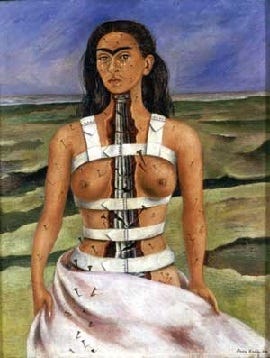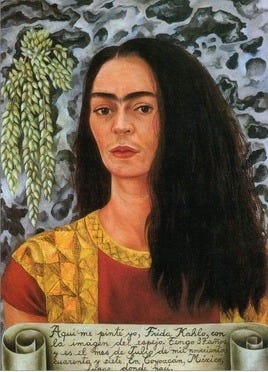On Becoming Your Own Muse
Lessons From Women Throughout History On How To Find Inspiration From Within.
Recently, I came across Anaïs Nin's writings. I must admit I was astounded by the magnitude of work she had completed in her lifetime but also by the versatility of her writing, poems, short stories, novels, diaries, and essays. I had vaguely known of Nin before. I knew she wrote erotica and fiction centered around female desire, but I had no idea that was just the surface. Anaïs was a woman who was indeed a force to be reckoned with; just her very existence compelled and bewildered others. Unsurprisingly, her diaries spanning over sixty years of her life would end up being the work for which she would become best known; Anaïs herself was the main attraction that lured others to her words. Her life journey was akin to a surrealist novel, whether she was living in Paris and having a complex and passionate affair with both Henry Miller and his wife June or studying psychoanalysis with Otto Rank Nin’s very essence was one of passion and inspiration, and it pervaded every area of her life, luring others into her orbit like a siren.
While becoming acquainted with her writing, I began to question what made Nin such an enchanting enigma. What made her a source of inspiration not just to others but also to herself? I found my answer in an essay Nin wrote titled The New Woman.
“For too many centuries women have been busy being muses to the artist. And I know you have followed me in the diary when I wanted to be a muse, and I wanted to be the wife of the artist, but I was really trying to avoid the final issue—that I had to do the job myself. “- Anaïs Nin
The answer was simple: Nin was the way she was because she was her own muse, the source of her inspiration and creations. She did not sit around waiting to be picked as the muse of another, no, she took initiative and did the job herself. Throughout history, women have been subjected to the role of the muse of others, mainly men; they are shrunken down to shining, animated objects ready to save a man and exist solely as a vessel for his ever-important creative ideas. (think manic-pixie dream girl trope). All the while, he steals her creative essence and energy and harvests it as his own.
“In the letters I’ve received from women, I’ve found what rank (Otto Rank) had described as a guilt for creating. It’s a very strange illness, and it doesn’t strike men.” - Anaïs Nin.
Nin challenges women not to be afraid to take up space and to not succumb to the submissive and invisible way of being society expects from them. She encourages women to call their power and voices back to themselves. To be your own muse, you must not be afraid to make yourself seen, heard, and known, regardless of the reactions or insecurities it may provoke in others. Becoming your own muse is allowing yourself the right to a fulfilling existence not dictated by the whims and wishes of outside forces.
“The Woman of the future, who is really being born today, will be a woman completely free of guilt for creating and for her self-development. She will be a woman in harmony with her own strength, not necessarily called masculine, or eccentric, or something unatrual. I imagine she will be very tranquil about her strength and her serenity, a woman who will know how to talk to men who sometimes fear her.” -Anaïs Nin
Nin urged women to save their inspiration and creativity for themselves. I’ve discovered that being your own muse not only enhances your creativity tenfold, but it's an act of radical self-love to center yourself and your life within your art, whether it may be writing, painting, filming, etc. So, I decided to do some research and discovered two other women from history who claimed themselves as their own muse in their art, similar to Nin.
Frida Kahlo
Frida Kahlo needs no introduction. She is perhaps one of the most prominent figures of the 20th century. Intensely brave and productive, Frida was known even to wear men’s clothing and cut her hair short when she was younger. Some viewed this as a deliberate act by a young Kahlo that challenged societal expectations about gender. When she was just eighteen years old, she was involved in a trolley accident that killed seven other passengers. Kahlo survived but was severely injured, spending many months in a body cast. Kahlo would experience pain and complications from this accident for the rest of her life, but this didn’t stop her from creating. By her death, Kahlo had created 143 paintings, 55 of which were self-portraits.
“I don’t paint dreams or nightmares, I paint my own reality” - Frida Kahlo
The evidence of Kahlo being her own muse is evident; amongst many of her most popular works exists one common denominator: they were self-portraits. A muse invokes a potent alchemy that allows her to heal and come to terms with the trauma of her past through her art.
Virginia Wolf
Virginia Woolf, one of the most influential fiction writers of all time, is known for originating stream-of-consciousness writing; Woolf was no stranger to the act of entering the depths of her mind and invoking the power of her inner muse. She argued in her essay ‘ A Room of Ones Own’ that women needed their own money and a room of their own if they were to write fiction. I believe this still holds true today. A muse needs her resources, freedom, and space to create freely from her soul without worrying about outside intrusions; she needs a quiet space to let her intellect submerge deep within the musings of her unique and creative unconscious.
“A woman’s writing thinks back through her mothers.” -Virginia Woolf
Woolf was known for placing aspects of herself in her fictional characters. In Mrs. Dalloway, readers can easily make connections between Clarissa Dalloway and Woolf herself. Similarly to Woolf, Dalloway was introspective and sensitive to the passage of time. In her novel Orlando In Orlando, Woolf plays with the idea of gender and identity roles by living vicariously through the protagonist she created. Becoming your own muse includes exploring your identity through the characters you create in your writing, attributing aspects of your personality and life to each of them just like Woolf did.
Becoming Your Own Muse
Virgina, Frida, and Anaïs all had one thing in common that allowed them to be their own muse: they were unapologetically creative and not afraid to be seen. In an era where the terms “afraid of being perceived” and “cringe” have been coined, it can be daunting to put yourself out there. But what if I told you terms such as this are often coined to discourage individuals, especially women from expressing themselves freely. There is nothing cringe about giving your art out to the world, people have been doing this for centuries, A muse is never afraid to be perceived, for she knows it is her birthright to bring her art to the world. Becoming your own Muse means breaking down the limitations and expectations of patriarchy, it means not worrying about being the perceived patriarchal ideal of the “It girl” But instead being your own It girl, and becoming your own audience, your own source of validation. Becoming Your Own Muse is something every woman is born to do.
“I am my own muse. I am the subject I know best. The subject I want to know better.” -Oroma Elewa.









Loved this provocation-do be your own muse
"she needs a quiet space to let her intellect submerge deep within the musings of her unique and creative unconscious."
The women you had featured have all been and continue to be muses to me but you named something that I had missed as to why. Thank you.
I really loved reading this piece and I have been thinking about this concept quite a bit lately! I think women are better creators when they get to tap into themselves as their own muses as well. So beautifully done, thank you for sharing!